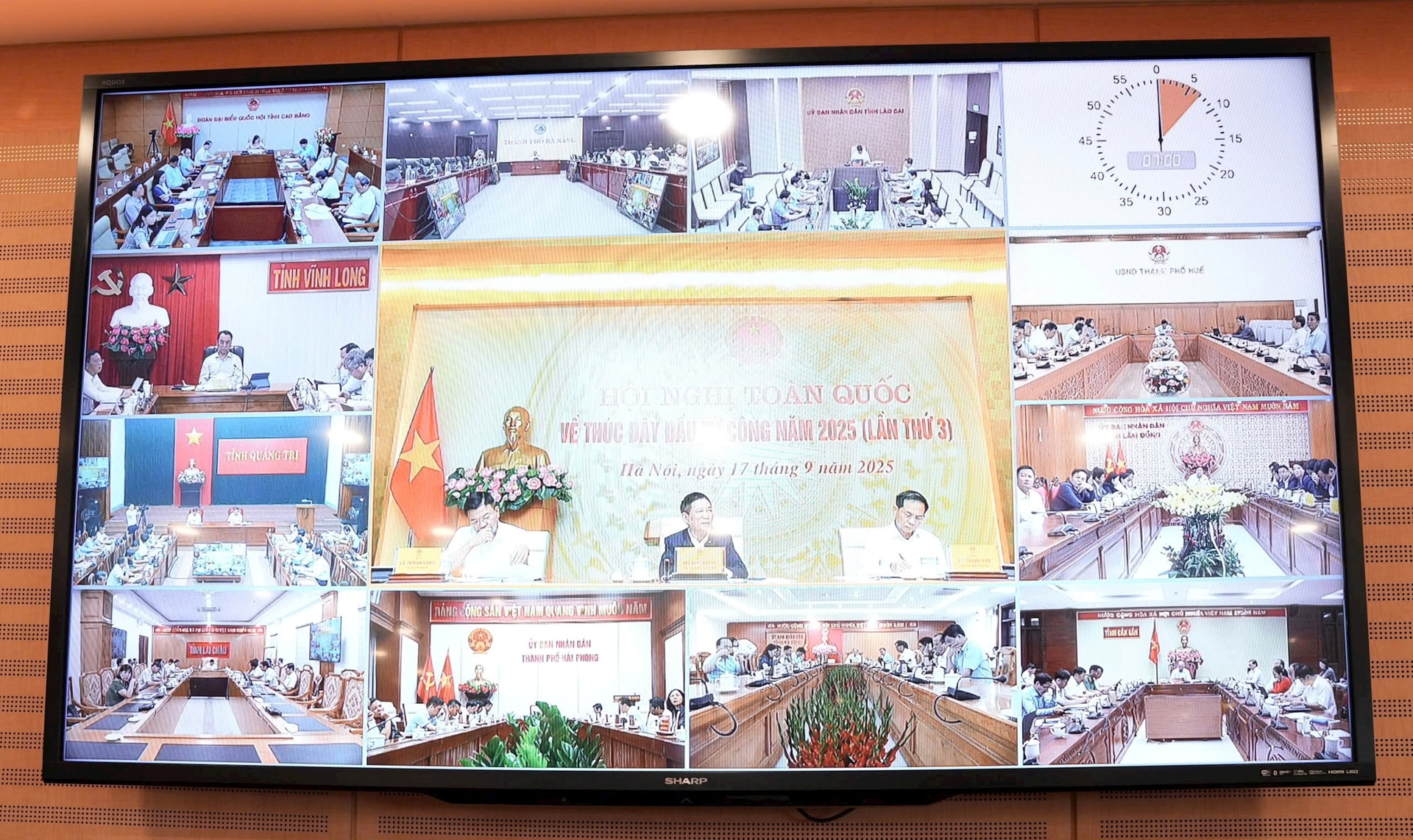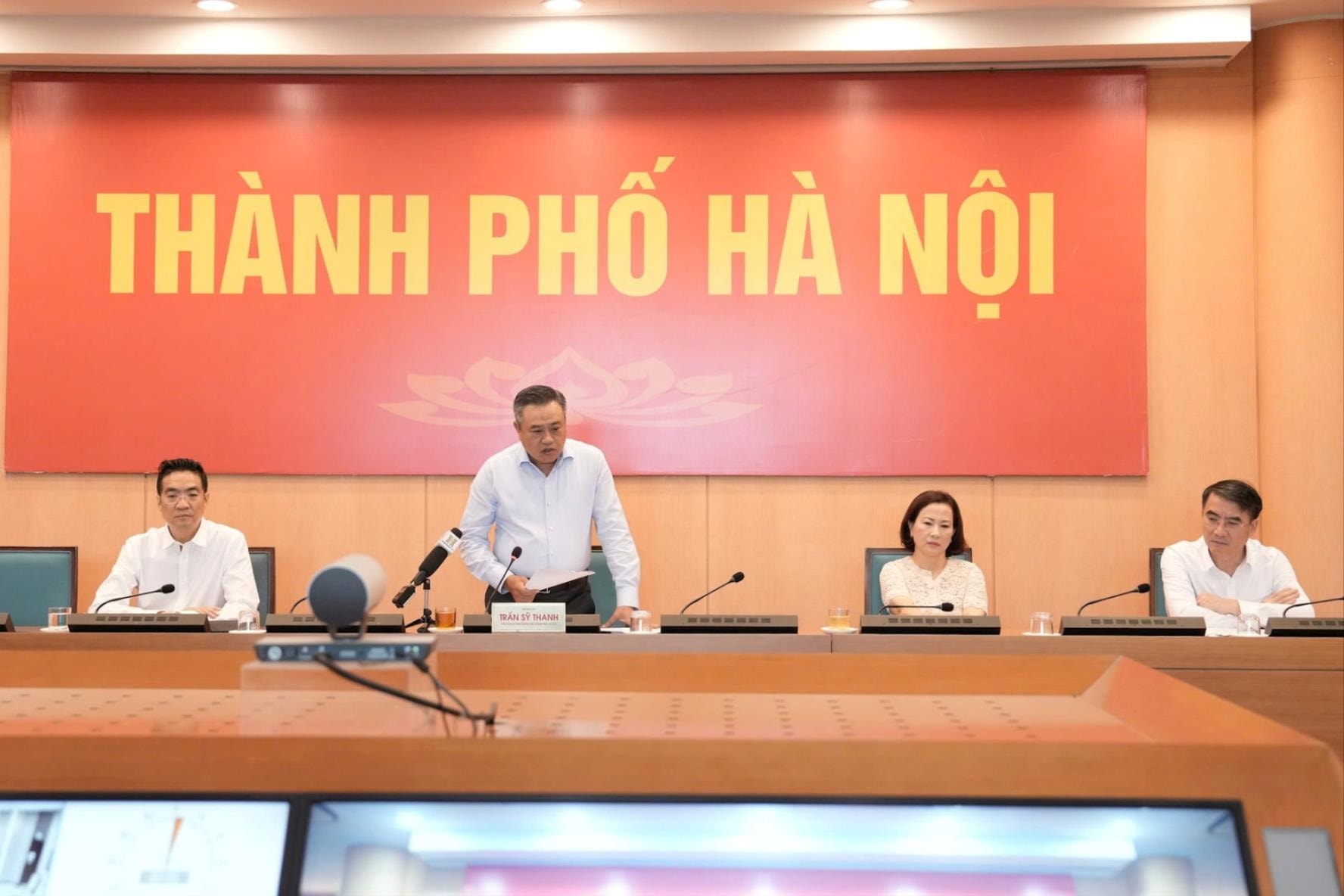Hanoi views rapid disbursement of public investment not only as a key growth driver but also as a political responsibility, said Central Committee Member, Deputy Party Secretary, and Chairman of the Hanoi People's Committee Tran Sy Thanh at the national online conference to accelerate public investment in 2025 on September 17.
He noted that Hanoi is one of the two localities leading the country in terms of absolute disbursement value.

Overview of the event.
For 2025, the Prime Minister assigned Hanoi a total plan of more than VND87 trillion (US$3.55 billion), 1.13 times higher than in 2024, which poses a major challenge for the city.
From the start of the year, Hanoi issued plans and directives and mapped out clear timelines and accountability for each investor and project to speed up disbursement.
By August 31, 2025, the city had disbursed VND36 trillion (US$1.47 billion), equal to over 41 percent of the assigned plan.
By September 30, disbursement is estimated at about VND39.3 trillion (US$1.60 billion), or 45.1 percent, which is lower than the national average by rate but places Hanoi among the top two in absolute value, 1.3 times higher than the same period last year.
During the celebrations of the 80th anniversary of the August Revolution and National Day, a series of major works were launched or inaugurated, giving new momentum to the capital.
These included the inauguration of the Yen Xa Wastewater Treatment Plant; groundbreakings for key bridges such as Van Phuc and Ngoc Hoi; site clearance for national projects like the North–South high-speed railway and the Lao Cai–Hanoi–Hai Phong railway; and new drivers such as the Hanoi Biotech High-Tech Park and the Smart City project.c

Chairman of the Hanoi People's Committee Tran Sy Thanh at the event.
From now until year-end, the city will start or complete additional important projects, including Thuong Cat Bridge, Urban Railway Line 2 (Nam Thang Long–Tran Hung Dao), Line 5 (Van Cao–Hoa Lac section), the Le Hong Phong Cadre Training School, the second campus of Hanoi Kidney Hospital, the Co Linh underpass, and the symbolic Tran Hung Dao Bridge slated to break ground around October 10, 2025.
"With the determination of the entire political system, the city will fulfill 100 percent of the public investment disbursement plan assigned by the Prime Minister by year-end," Chairman Tran Sy Thanh stated.
Hanoi has been proactive in implementing the two-tier local government model. All 126 communes and wards manage their own budgets without delays in account opening, budgeting, or appointment of chief accountants, and the city advanced funds for social welfare to avoid disruptions during the transition.
For public investment projects, the city closed budget settlements across the system as of June 30 before the model took effect and cataloged projects for decentralization and delegation to the 126 communes and wards after the administrative reorganization.
About 10 percent of public investment projects remain at the city level, while 90 percent of district-level projects were reassigned to the commune level from July 1, 2025, and disbursement has stayed on pace, showing effective operation at the grassroots level.
The city recognizes that disbursement still falls short of expectations and that bottlenecks persist, especially among priority projects and those using central budget funds, ODA, or extended capital.
Beyond market fluctuations and material shortages, three main issues remain: the lack of implementing guidance for the amended PPP Law regarding land-for-BT contracts, lengthy procedures for negotiating and signing ODA loan agreements, and persistent obstacles in site clearance related to land origin, pricing, and inconsistent compensation policies over time.
Capacity constraints among some commune and ward officials also pose challenges after they took on nearly 27,000 projects.
To address these issues, Chairman Tran Sy Thanh proposed that the Government promptly issue decrees guiding the amended PPP Law on land-for-BT contracts.
He stressed that many projects in Hanoi and other localities are waiting for this guidance to sign BT contracts, which is vital for creating fiscal space for coming years and for achieving double-digit growth.
He also pointed out that the scarcity of embankment materials and the large gap between published price lists and market prices could seriously affect cost estimates, contractor selection, and project execution, urging a nationwide mechanism that reflects real market conditions.
On site clearance, he acknowledged the Government and ministries have removed many obstacles, yet policy inconsistencies still appear across ongoing projects, forcing Hanoi to select optimal but sometimes time-consuming solutions.
From now to year-end, Hanoi commits to stronger action to achieve 100 percent disbursement of the 2025 plan and extended capital. The city will tighten discipline, use disbursement results as a top metric for cadre evaluation, and hold leaders and responsible individuals to account.
Hanoi will focus intensely on site clearance, establish special task forces to resolve complex priority projects, and manage capital plans flexibly, shifting funds from slow projects to those with good progress while seeking central consideration for state budget and ODA resources.
With the highest sense of responsibility and political resolve, Hanoi will continue close coordination with ministries, sectors, and localities to overcome difficulties, complete the public investment disbursement tasks, and contribute to the country's overall development.